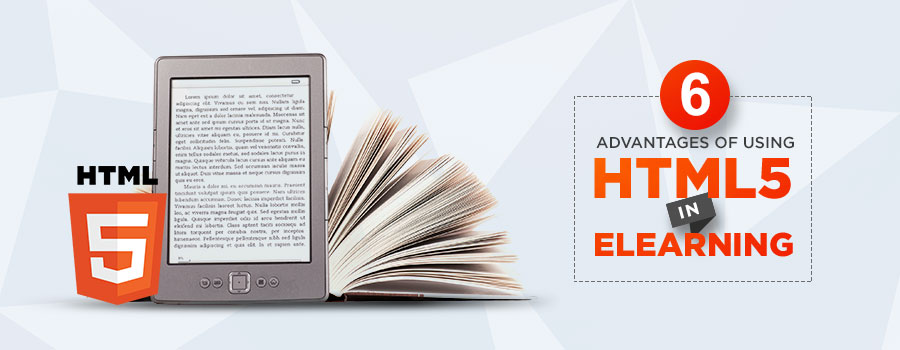Adobe Flash had been one of the foremost tools for authenticating eLearning courses until HTML5 came into the forefront. It was known for the high interactivity level, engaging animation and immersive graphics. However, HTML5 is a better alternative as an eLearning authoring tool, given that it is more compatible with mobile devices than Flash. This has led to the popularity of HTML5 among the eLearning professionals. Here, you will come to know about the key benefits of using HTML5, while choosing an eLearning authoring tool.
Wider reach to the audience
The number of people using internet through mobile devices has increased over the years and the internet users will keep on increasing. Today, most of the people get access to the eLearning courses through tablets and smartphones. Evidently, the eLearning professionals are striving to make these resources more available to them. The best way to ensure technical support to the readers is to make use of HTML5 owing to the fact that most of the mobile devices do not support Flash. Particularly, Flash is not compatible with iPads and iPhones. Besides, the readers can study these materials while they are on the move, as they are available on their mobile devices. Failure to reach out to the reader base can affect the business. Most of the eLearning professionals are pairing up with digital conversion companies to ensure compatibility with the mobile devices. The HTML5 authoring tools ensure that the eLearning resources can be read on mobile devices with various screen sizes. The experts can also develop smart meta tags, which makes it possible to optimize the eLearning course for the mobile devices.
More accessible to learners
Today, a large section of the learners do not get the opportunity to read the eLearning materials on their computers due to time crunch; they lack the time to switch on their systems, sit and read. Using HMTL5 authoring tools for eLearning makes new information available to a larger learner base as they can get access to the study materials or training resources through their mobile devices while they are on the move. They can get access to the eLearning materials from any given location, even when they are offline. The users can simply store the data after downloading them and read them later on, without getting connected to the internet.
Easy customization
One of the key advantages of using HTML5 in developing eLearning courses is that the materials can be customized according to the requirements of the eLearning professionals. When you create interactive html5 content, you can customize it with ease. Flash, too, provided good customization features, but certain limitations existed in the process. Using HTML5, they can get the course customized without any of these restrictions. Here, the flow of eLearning materials can be customized, adapting it to the viewing panel. This makes the resources accessible on various screen sizes and browsers which is a great boon. The eLearning professionals need not install plugins or use any other third-party program for making these modifications. A simple change in coding can help you deploy the eLearning courses and online applications rapidly. These can automatically work across all online platforms, browsers and operating systems.
Multi-browser support
It is necessary for the learners to download a plug-in or trademarked player in order to access the online courses based on Flash. However, they can get an immediate access to HTML5 on Mozilla Firefox, Microsoft Internet Explorer, Apple Safari or Google Chrome, without downloading plugins that enable web browsers to interpret the code. This is why the eLearning professionals are seeking flash to html5 conversion support from various reputed platforms. This compatibility comes with a number of secondary benefits for the company, as more learners are likely to enroll for the courses. They can log inconveniently in quick time in the course and save valuable time. This helps them stay more focused on the course.
Multimedia integration
The users can access the videos integrated into the HTML5 course from any platform or browser. Previously, the videos used to appear as a block box, in case the user did not have the application or plugin. However, one of the major features of an html5 interactive video is that they allow easy integration of multimedia by removing the necessity for making the presentations searchable. The eLearning professionals can develop interactive and dynamic courses, featuring multimedia presentations. This strengthens the engagement of the target groups, providing them with a more comprehensive experience in eLearning. Irrespective of the device or browser they are using, they can get access to these resources.
HTML5 defines the new standard in the industry
The eLearning professionals are gradually shifting their flash-based courses towards HTML5, as it has emerged as the new standard in the industry. Over the globe, the professionals are designing their courses using HTML5. It comes with a number of benefits and refines the quality of learning to a great extent. Evidently, the integration of HTML5 as an eLearning authoring tool has emerged as an established standard in the industry. The learners expect the eLearning platforms to come up this sort of experience for them.
Evidently, HTML 5 brings an interactive e-learning platform and offers a number of features to enhance the experience. The eLearning professionals are collaborating with experts to integrate HTML5 in their platforms. The eLearning industry is likely to expand further, with the sophisticated technologies of HTML5 refining the eLearning experience. You can reach out to PGBS, one of the established companies in the industry for the necessary support. The experts will help you out with Flash to HTML5 conversion services and you can come up with a more robust platform for eLearning.

